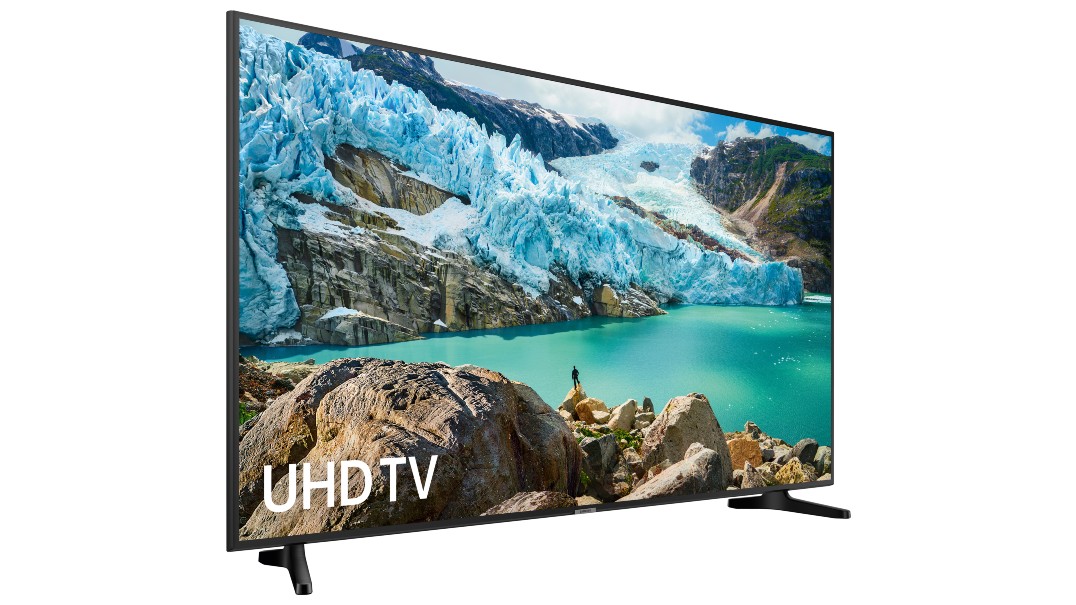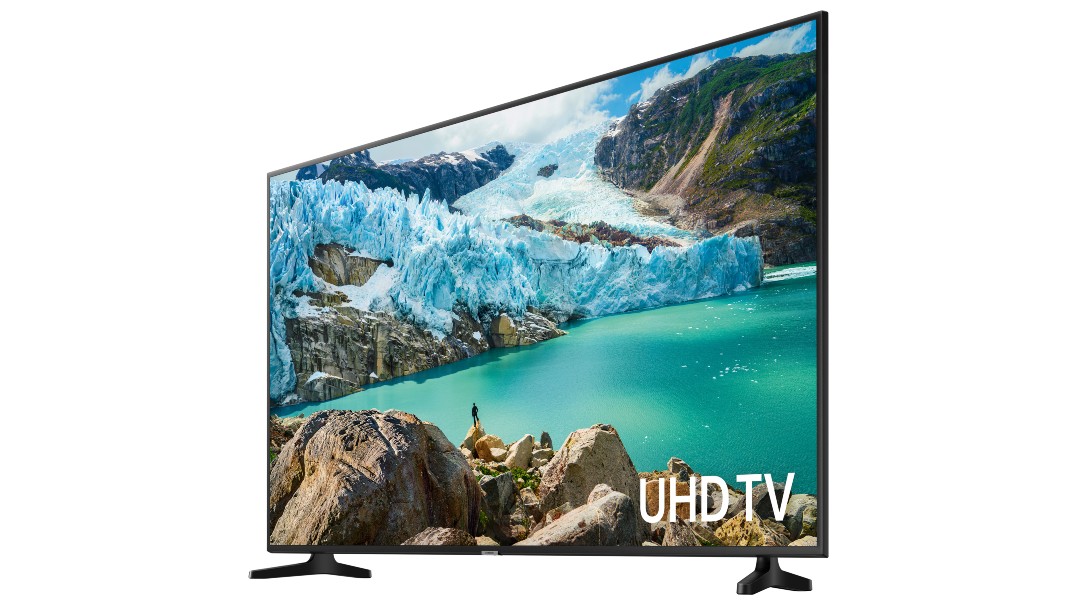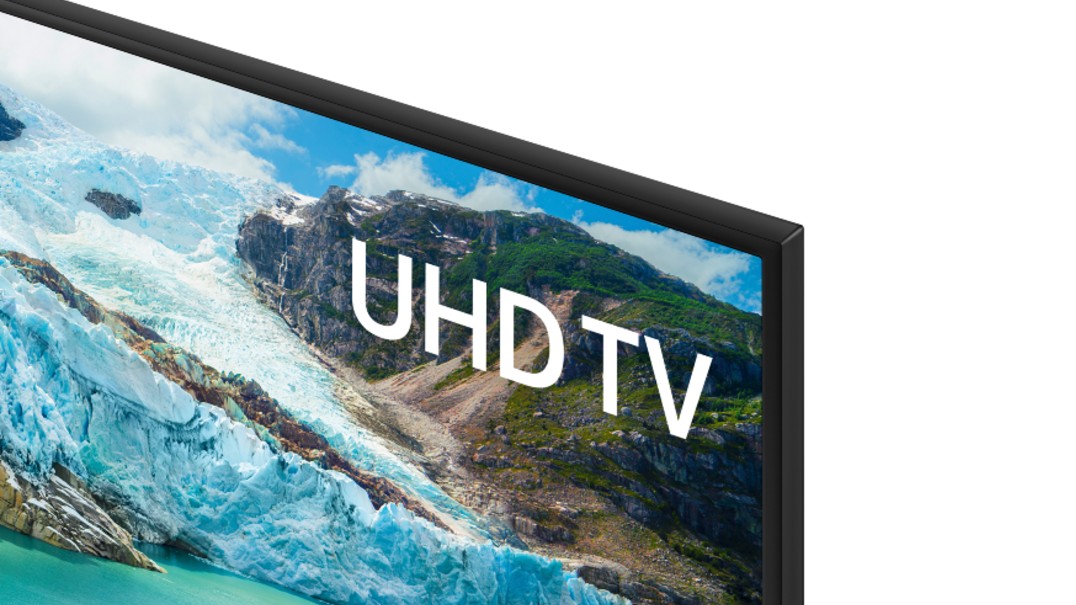TechRadar Verdict
For once with an entry-level TV, the pros far outweigh the cons. Impressive color balance and good contrasts help towards stable, effective images and Samsung's Tizen Smart TV platform is better than the OS on any other small, affordable TV that isn’t a Samsung.
Pros
- +
Impressive color and motion-handling
- +
Efficient scaling
- +
Outstanding OS
Cons
- -
Harsh sound
- -
Woeful remote
- -
Some localized picture quality issues
Why you can trust TechRadar
Everyone’s happy that enormous, expensive, wildly over-specified televisions exist. But most of us can’t afford them, can’t find space for them or, frankly, don’t want them. Seriously, are you in the market for an 88-inch 8K TV that costs as much as a nice Mercedes?
Of course you’re not. What you want is a realistically-sized, realistically-priced TV with an up-to-date but real-world specification. And ideally you want it from a brand with a proper reputation (and, perhaps, from a brand with a huge, expensive and impractical TV or two in its line-up. Just for a bit of reflected glory, you understand).
Samsung can tick all of your pragmatist’s boxes. Its RU7020 range is affordable yet well-specified, starts with this titchy 43–inch screen size – and wears a badge with a sight more credibility than most of its price-and-size-comparable rivals. If you’re a subscriber to the ‘buy the worst house on the best street’ school of financial decision-making, the UE43RU7020 might be for you.
After all, ‘small and affordable’ doesn’t exactly equate to ‘poverty spec’ in this instance. The RU7020 is a 4K LCD TV with HDR10+ compatibility and the same Tizen-based interface as Samsung’s best smart TVs. It even works with Amazon Alexa or Google Assistant voice control.
At this point, then, the question is not so much “why would I want an RU7020?”, more “why wouldn’t I?”
Price and availability
The Samsung UE43RU7020 4K TV is available to buy for $339 / £339, which works out at around AU$640 based on current conversion rates.
For comparison, the best 4K TV we've tested, the Samsung Q90 QLED TV, comes in at $3,499 for the 65-inch version (the smallest size available in the US). So, at ten times cheaper than Samsung's flagship display, how does the brand's budget option measure up?
Sign up for breaking news, reviews, opinion, top tech deals, and more.

Design
Screen size: 43in
Tuner: Freeview HD
Panel technology: LCD/LED
Panel resolution: 3840 x 2160
Smart TV: Samsung/Tizen
HDR: Yes
Inputs: 3 x HDMI, 2 x USB, digital optical, component, composite, Ethernet, RF, CI slot
Dimensions: 56(h) x 97(w) x 6(d) cm
Weight: 9.6kg
If price-related sacrifices are to be made, better they’re made here than down in the sections covering picture quality. And sure enough, while there’s absolutely nothing wrong with the way the UE43RU7020 is put together nor the materials from which it’s made, Samsung hasn’t exactly gone to town with the design of this TV.
At least Samsung hasn’t tried to disguise any of the plastics that comprise the bezel, the rear and the feet of the RU7020. The rear panel, with its cutaways for inputs and mains power lead, is pleasantly (if rather pointlessly) textured, while the smooth plastic bezel surrounding the screen is surprisingly (and happily) brief.
Its simple plastic feet sit near the edge of the chassis, so you’ll need a reasonably wide surface on which to stand it. Mind you, at 56 x 97 x 6cm (H x W x D), 9.6kg and mini- or Vesa wall-mount ready, it’s far from tricky to position it on a wall instead.
Inputs run to three HDMI 2.0 sockets (one ARC-enabled), a couple of USB sockets (neither of which can be used for PVR purposes), component and composite analogue inputs, a CI slot and an Ethernet socket. TV reception is via an RF socket - there’s no satellite tuner. Integrated Wi-Fi, Apple AirPlay 2 and Bluetooth offer wireless connectivity, and there’s a digital optical Toslink output.
Up to this point, the UE43RU7020 does everything you could reasonably expect at the price. It’s a shame, then, that the remote control is ready to accuse you of being a cheapskate every time you pick it up. It’s too small, the buttons on it are too small and too numerous, and the TV is tardy in its responses.
Putting the Samsung on the same network as one of the best smart speakers will give a degree of voice-control, but for everything except the basics you’re stuck with this deeply unsatisfactory handset. Anyone with fingers wider than cocktail sticks and/or eyesight any less than perfect will find it irritating in the extreme.
Despite the price, this TV doesn’t feel built down to a price - build, finish and connectivity are all well up to standard. The remote control, though, is woeful.

Smart TV
The RU7020 enjoys the same Tizen-based OS as Samsung TVs costing ten times as much and, as a consequence, it’s streets ahead of the majority of entry-level 4K sets it’s competing against.
The menu is clean, legible and doesn’t occupy the entire screen - so already it’s ahead. It’s packing all the apps you are likely to need, including Apple TV, Netflix, Amazon Prime Video, YouTube, and all the rest. Downloading, deleting or rearranging apps is as simple as attaching your TV to your local network, and the appropriate streaming services have HDR and surround-sound options available too.
Operating systems as intuitive, friendly and helpful as this are few and far between at any part of the market. Even the EPG (Electronic Program Guide) is a cut above the norm.

HD/SDR performance
The RU7020’s 3840 x 2160 resolution is governed by Samsung’s UHD processor and, in general, it does a pretty decent job of employing all those pixels when the source material is of a lower resolution.
From BBC One HD’s Match of the Day (constant motion, big blocks of uniform color and on-screen movement that often opposes camera movement - it’s almost a big a test of your TV as VAR referrals are a test of your patience) to a 1080p Blu-ray of ‘the Coppola restoration’ of The Godfather, the Samsung upscales well.
Colors are reasonably vibrant without looking artificial, and there’s strong contrast between properly deep black tones and clean, clear whites. The 60Hz panel handles motion impressively (after some fiddling in the depths of the set-up menus), and enough detail is retained to make textures convincing.
Low-light scenes (of which The Godfather has plenty) reveal the 7020 to be rather ‘one-note’ where blacks are concerned, though - they can get crushed to uniformity quite easily, where more capable (read: more expensive) alternatives will deliver more gradation.
Older, less painstakingly remastered material can end up a little coarse and noisy once upscaled to fit the Samsung’s panel and, again, black detail can readily go astray. There’s authentic restlessness is most of the predominantly black scenes in The Godfather, but the Samsung does manful work with complex patterns and resists dot-crawl well. In broad terms, and with your expectations balanced against your budget, there’s plenty to admire about the way the RU7020 handles content designed to fill, at most, a quarter of the number of pixels in its panel.

4K/HDR performance
Switch to some 4K content from, say, Netflix or Amazon Prime or a UHD Blu-ray player, and the Samsung UE437RU7020 really comes into its own. Despite being tricked out with Samsung’s less celebrated PurColor technology (more expensive Samsungs benefit from Dynamic Crystal Color processing), the 7020 paints from an expansive and convincing color palette.
A disc of Blade Runner 2049 allows the Samsung to make a pretty strong case for itself. As well as describing really convincing colors, with subtle gradations of tone handled well and enough detail retrieved to properly describe textures, black tones improve significantly over their HD equivalents.
For an edge-lit LCD screen, the 7020 maintains great backlight uniformity - and allows bright whites to coexist with deep blacks without significant problems. Black tones are much more nuanced at the Samsung’s native resolution, with much more insight and much less crushing apparent. This isn’t the most out-and-out bright screen you ever saw, but its contrasts are nevertheless wide and convincing.
The 4K Blu-ray disc of the classic Alien enjoys HDR10+ encoding, and the Samsung does broadly impressive work with the information. The endless blacks of space are good and deep, with bright, seemingly unclipped whites happy to exist in the same scene. The predominantly green/blue/grey color palette is wide-ranging and expressive, and edges are sharp and stable. Motion is handled nicely too, with real solidity even during the moments of highest crisis.
By far the most jarring moments of the 7020’s 4K HDR performance come if you decide to do the decent thing and engage ‘Eco’ mode. During a stream of Amazon Prime Video’s hugely ambitious and thoroughly good-looking King Lear, on a couple of occasions the screen is seen hunting between HDR settings, allowing the grey/black colour behind Florence Pugh’s Cordelia to fluctuate between ‘dark’ and ‘not so dark’ obviously and abruptly during one of the earliest scenes.
It’s not a good look, and it spoils the rest of the experience just a little. Which is a great pity, because no one wants to choose between saving the planet or spoiling their viewing experience. in terms of detail fidelity and motion stability the 7020 looks a fair bit more expensive than it actually is – unless you’ve deployed ‘Eco’ mode. It makes one rather cynical about what the option is doing there in the first place.
4K gamers won’t care too much about any of that, though. Not when they get a load of the 10ms response time the Samsung’s capable of in XX Mode. That’s about as fast as a TV ever gets, and is not to be sniffed at.

Sound performance
The remote control, it turns out, isn’t the only way the Samsung gives away its position in the model hierarchy. It’s fitted with two full-range drivers, each in receipt of ten watts of power - but while there’s no doubting the clarity of the the 7020’s audio delivery, in most meaningful ways it’s impoverished.
The Samsung’s predictably short of bass weight – the relentless low-frequency wallop of The Lego Movie is no more than alluded to. What’s less likely, or justifiable, is the implacable hardness and coarseness of the 7020’s high frequency response. Doesn’t matter if it’s a DVD copy of Zoolander or a Netflix stream of What Happened, Miss Simone?, the Samsung’s top end is brittle and unyielding, requiring only mild abuse of the volume control to become coarse and tiring.
There’s similar stridency in the midrange, too - and when voices get animated (as they surely must during Match of the Day) the 7020 sounds flat, hard and two-dimensional. Other similarly priced TVs lack the directness and clarity of the Samsung, but the 7020’s overall sonic experience is far from relaxing. If your audio system is up to it, you could do a lot worse than use that HDMI ARC output to beef up and calm down your TV sound.
‘Flat and thin’ might be good news in a pizza base but it makes for an uncomfortable listening experience.
Other TVs to consider
If you’ve been hunting for a fairly affordable 43-inch 4K TV, you know you’re not exactly spoiled for choice – and if you want one from a brand with a bit of recent profile and traction, your selection is narrowed down even further.
Nevertheless, you’re not entirely without options.
For more or less the same money, and with more or less the same specification, LG’s 43UM7500PLA certainly needs a place on your shortlist. It’s a 4K HDR LCD TV and, rather than being better or worse than the Samsung, it’s simply different - it doesn’t have the Samsung’s facility with the deepest blacks or starkest contrasts, but it’s more vibrant and detailed (and less prone to uncertainty) with HDR content.
Philips’ Ambilight-toting 43PUS7734 can be yours too – although admittedly it costs a chunk more than the Samsung. Or you could go in the other direction and have a glance at the Hisense H43B7500 – it’s usefully cheaper than the UE43RU7020 but, then again, its shortcomings make it something of a false economy.
Really, the thing to do when it comes to considering alternative TVs is to consider this Samsung UE43RU7020 around Black Friday. By then it’s almost certain to look even more of a bargain.
Final verdict
The Samsung UE43RU7020 isn’t perfect. In the most bald terms it sounds rotten, is operated by a rotten remote control, it has several black-tone issues with HD material and it is occasionally flummoxed by HDR encoding.
Yet, by prevailing standards (of screen-size, price and specification) it’s actually pretty impressive. You’ll have to ignore the shortcomings above, of course, and the temptation of ‘Eco’ mode – but once you do you’re left with a TV with a strongly naturalistic color balance, fine contrasts, excellent backlight control and the best OS at anywhere near the price.
A TV that deals confidently with motion, draws edges with a steady hand, dishes all available details and responds like that to gamers’ inputs. All in a frame that doesn’t look like it belongs in the bargain bin.
The smallest, most affordable Samsung 4K TV of the lot is not to be ignored. Certainly not when Black Friday rolls around.
- The best ultra-HD 4K TVs in the world today
- Get the best deal on Samsung products with our Samsung coupon codes.

Simon Lucas is a senior editorial professional with deep experience of print/digital publishing and the consumer electronics landscape. Based in Brighton, Simon worked at TechRadar's sister site What HiFi? for a number of years, as both a features editor and a digital editor, before embarking on a career in freelance consultancy, content creation, and journalism for some of the biggest brands and publications in the world.
With enormous expertise in all things home entertainment, Simon reviews everything from turntables to soundbars for TechRadar, and also likes to dip his toes into longform features and buying guides. His bylines include GQ, The Guardian, Hi-Fi+, Metro, The Observer, Pocket Lint, Shortlist, Stuff T3, Tom's Guide, Trusted Reviews, and more.
